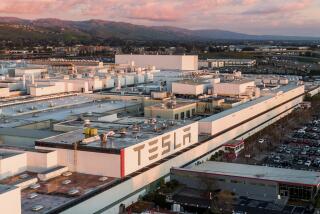U.S. Company’s Smelter Blamed for Acrid Pollution in Peruvian Town : Environment: Sulfur dioxide from plant is choking the once-productive Ilo Valley.
ILO, Peru — Thick, acrid smog envelops Manuel Espejo’s withering olive trees. He has pruned them severely in hopes they can be saved.
Espejo blames the damage on the fog laden with smoke from the nearby smelter of the Southern Peru Copper Corp., owned by a consortium of Asarco Inc. of New York and three other U.S. firms.
Farmers and local officials say sulfur dioxide spewed from the smelter’s four towering stacks is choking the once-productive Ilo Valley, 580 miles southeast of Lima.
“The smoke burns all the little leaves,” Espejo said. “A sprout comes out and it’s burned, burned, burned.”
Company vice president Charles Smith contends the agricultural problems are caused by poor management and lack of water on Peru’s desert coast.
Peruvian Indians were engaged in mining long before the Spanish conquistadors began taking silver and gold from the Andes more than 400 years ago. Now the industry is enjoying a renaissance under the government’s new openness to foreign investment.
But pollution, once ignored, has become a major issue. It may help explain why no one bid for the state-owned Centromin complex, Peru’s largest mining company, when it was up for auction in May.
Dick Kamp, a U.S. environmentalist, described the pollution from Centromin’s seven mines and its smelter at La Oroya as a “vision from hell.”
Mayor Ernesto Herrera Becerra of Ilo, a town of 60,000 people, said pollution from Southern Peru Copper had harmed agriculture, poisoned miles of coastline and ruined fishing in some areas.
A thick gray sludge of tailings from the company’s two mines in the highlands runs into the ocean 30 miles south of Ilo through the old channel of the Locumba River, which has been diverted for irrigation. Slick, slate-colored silt covers the beaches and crusty deposits of mineral waste tint the shoreline fluorescent hues of green, yellow and blue.
Waste called slag has blackened three miles of beaches around the smelter north of Ilo where Southern, the country’s largest copper-mining operation, produces about 300,000 tons of copper a year.
“We believe Southern is a very important company here, but it is possible to have development while conserving the environment,” Herrera said.
For Ilo and the national economy, Southern is a mixed blessing: It provides 5,500 jobs and 17% of Peru’s export income, but it is a major environmental headache.
Herrera said the economic issue “is the blackmail international companies use on countries with weak economies dependent on raw materials.”
He thinks the worst problem is the sulfur-dioxide smog. On days when it covers the town, children cannot play outside. The mayor and other officials said respiratory ailments are common in Ilo.
Brian Johnson, the company’s environmental engineer, acknowledged that sulfur dioxide is “present and we need to correct the situation. At times it’s irritating.”
Johnson added, however, that sulfur dioxide is not toxic and that the U.S. Environmental Protection Agency describes it merely as an irritant.
Olive grower Jose Valencia said the smelter emissions had driven farmers from their homes in the valley, and that most commute from Ilo to work their land.
“They can’t stand the smoke,” he said. “None of the farmers live there. What the company wants is for all the farmers to leave. I have 25 hectares (62 acres). If I leave, it will be like cutting off a leg.”
Kamp, director of the Border Ecology Project in Bisbee, Ariz., said after a visit to Ilo that “Southern has perhaps the world’s dirtiest copper smelter.”
He said it emits about 2,000 tons of sulfur dioxide a day, or 15 to 20 times the limit for U.S. plants.
Smith, the vice president and operations manager, said Southern pays farmers for crop damage but does not concede that the smoke actually causes it. He said the government, “with little recognition of the facts,” requires the payments.
Southern plans to spend $300 million on modernization over five years, Smith said, two-thirds of it for such environmental purposes as reducing emissions and disposing of tailings without dumping them into the Pacific. He said a $110-million plant will be built to convert sulfur dioxide into sulfuric acid for use in the mining operation.
Critics say the plans will reduce sulfur-dioxide emissions by only 20%. Smith responds that it is “economically impossible” for Southern to capture all the emissions because there is no market for the sulfuric acid that would be produced.
More to Read
Sign up for Essential California
The most important California stories and recommendations in your inbox every morning.
You may occasionally receive promotional content from the Los Angeles Times.










